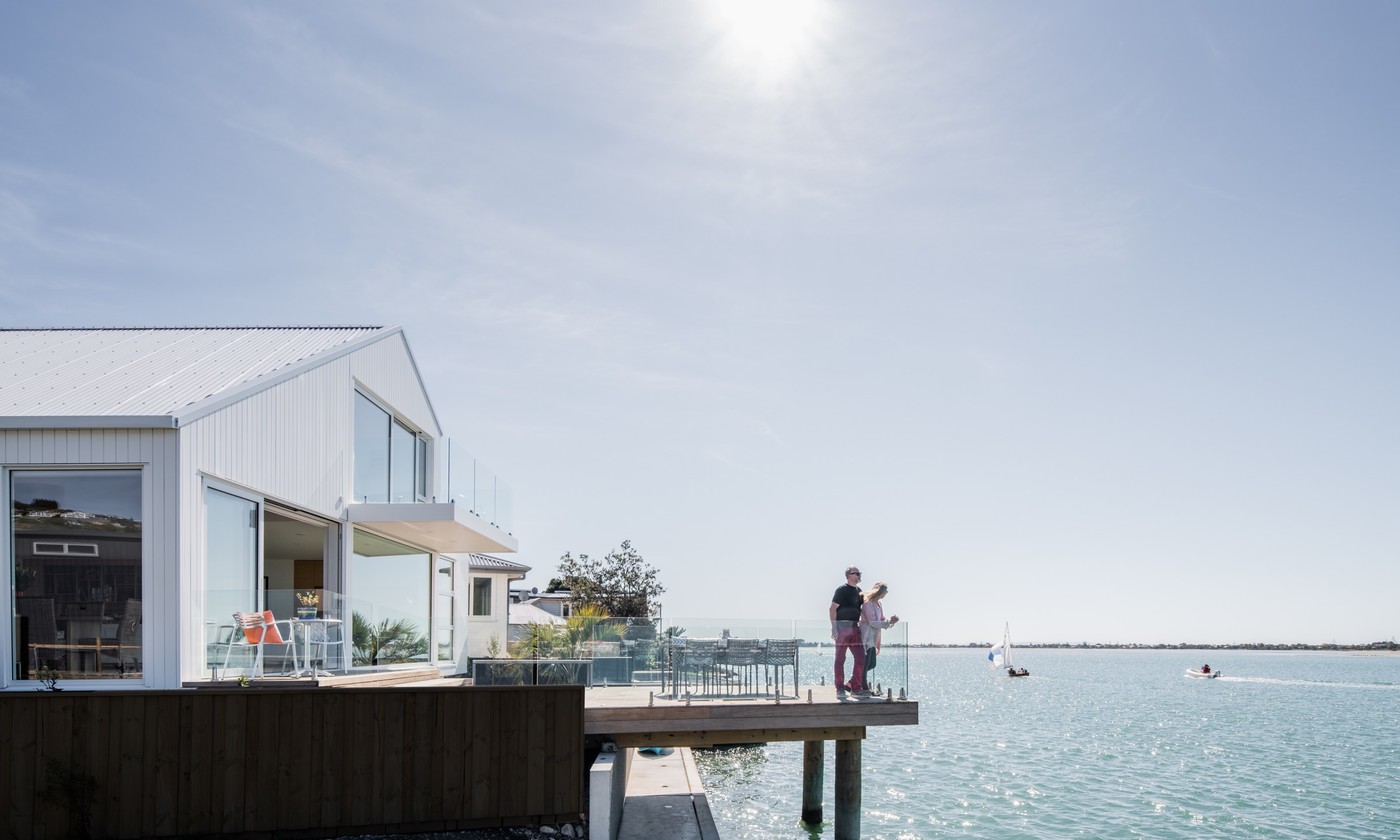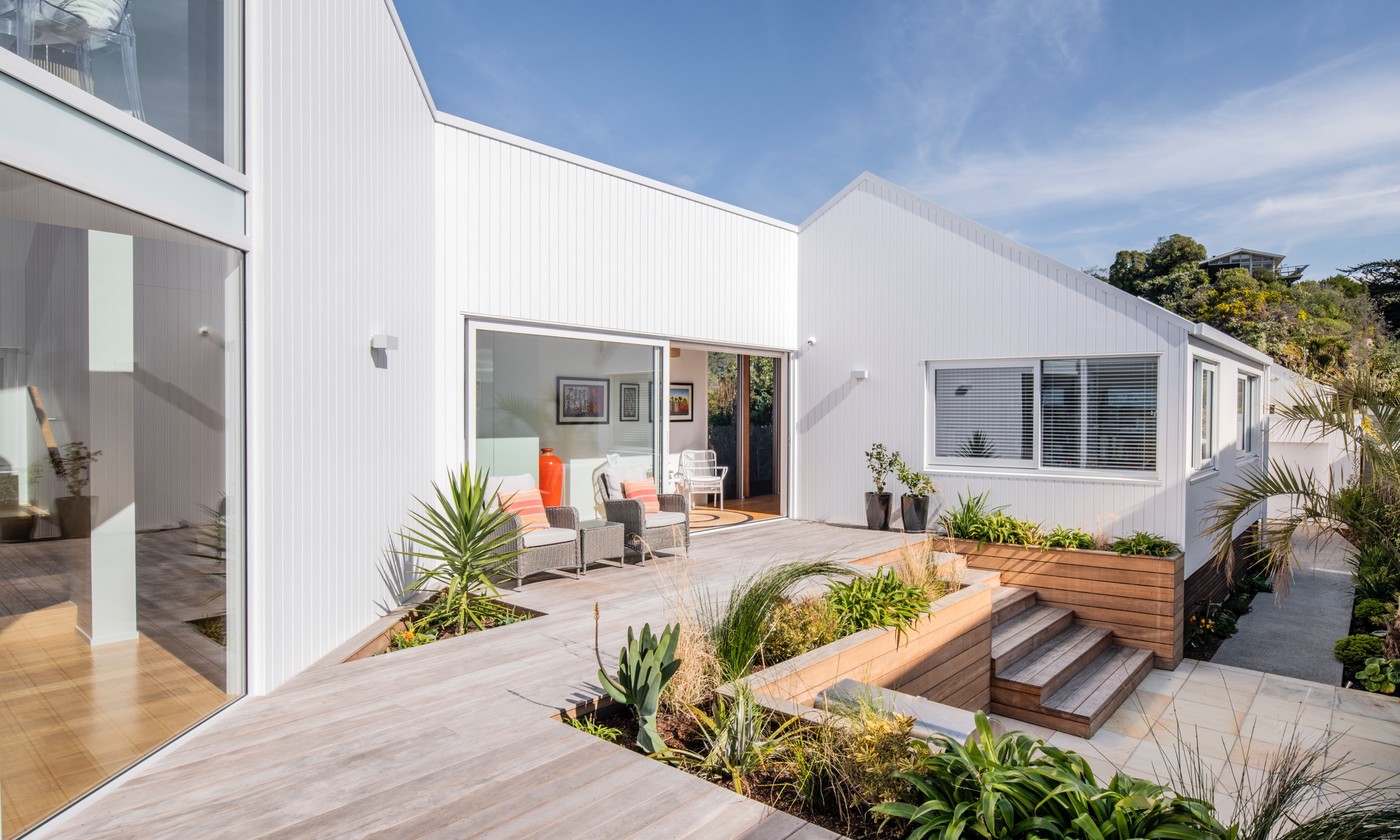For 28 years our focus has always been on enriching the way people live, work and play through architecture.
Avenues
At Water's Edge
December 2020
Every collaboration, whether it’s a marriage, a business proposition, or the building of one’s home is a lesson in thoughtful compromise. Bringing together two distinct visions for a home is no mean feat. Still, architect Richard Dalman has created his own home with a partnership of his love of contemporary designs and minimalist detailing, and his wife Marion’s affection for water and seaside living.
This is the Water House.

Situated on the Christchurch Estuary (Ihutai) in Redcliffs, the site of the Water House is ensconced in its coastal position – this is on the main road to Sumner Beach and extends all the way to the water’s edge. In fact, the boundary for the property falls in the water.
With the challenge of construction in such a locale presented, the land was fully remediated pre-build with a combination of stone piles and a 300mm concrete slab. From the street, there is a 7.5m narrow frontage. The site angles outwards toward the water to a 14.5m wide boundary. Access to the house was obviously from the road, but Richard and Marion’s wish to live on the water’s edge meant a long, narrow house was designed to achieve this.
The couple wanted a design that would minimise the effects on the estuary, and the neighbours. The clever design allowed the pitched roof planes to be continuous the length of the building.
While this is a long house, there are two distinct ‘cut-outs’; one for a service court combined with a third vehicle or small boat park, and the other a generously sized, partially covered courtyard that is a sunny retreat from the prevailing Christchurch easterly wind.


A tall urn fountain bubbling under a palm tree enhances the sense of serenity and quiet relaxation in this space. The entrance to the house is to the side via ‘floating’ granite steps. The lobby affords access from both the garage and front entry steps and also leads to a spacious guest suite that can be used by friends and family when they come to stay.
Providing passage from one end of the house to another is a long corridor. Along this hallway, the architect has increased the width to form a gallery which provides a journey, with floor to ceiling cedar fins framing tall glass panels, and large glass sliding doors affording different views along the way. There is even enough room for a sunny afternoon sitting area.
At the end of the gallery is an atrium space that turns a corner to reveal 180-degree water views from the open plan living areas.
These encompass a generous kitchen, dining and living area with continuous glazing affording floor to ceiling views across the estuary to the South Brighton Spit, Sumner Bar, and the Pacific Ocean beyond. In order
to make the most of the iconic setting, one window is the largest double-glazed unit produced in Christchurch for a residence and meets the client’s requirement for an unobstructed water view.

Various other structural elements work to connect the sea with the home; sliding stacker doors open out to the deck that doubles as a pier out over the water.
Marion’s love of water meant this needed to be the main focus of the house. This certainly has been achieved. Even in her home office, Richard has carefully framed a view across the courtyard and through the large glass windows of the living area out to the estuary. Despite the water focus, there are still views up to the hills behind from well-placed windows.
The atrium space at the end of the gallery also provides access to the master suite via a second set of stairs framed by four-metre-high oak slats.
Heath Waters, General Manager for Clive Barrington Construction, who were responsible for the build, mentions that the stairs are one of the most notable achievements throughout the build process.
“From a pure carpentry point of view, the stair balustrade appears to float above the floor and beneath the ceiling with minimal visible connection to the stair. Oak is such wonderful material to work with and the decorative blocking adds to what really is a very clever detail – tricky to execute but well worth the investment in time and planning.”



Materials for the house have been carefully selected to provide a seaside aesthetic, such as aqua glass tiles to the bathrooms that shimmer like pāua shells, grey granite vanity tops with a tidal pattern, and two types of floor tiles that look like a stony beach and a sandy beach respectively. Oak floors, stairs, and joinery complete the light, informal look. Materials are also durable for the seaside location, utilising top quality colour coated aluminium roofing and powder-coated aluminium joinery, high-quality Resene painted vertical cedar boards, and stainless-steel fittings – all are sure to withstand its waterside location, and the changeable conditions that New Zealand is well known for.
Landscaping around the house features succulents and Māori Princess Pōhutukawa that are prevalent in the Redcliffs and Sumner area, which tends to enjoy a warmer winter than Christchurch city. Olive trees create visual privacy along one boundary; their first growing season provided a bumper crop of olives, preserved by Marion and enjoyed by many.
While a glass balustrade was obvious for the deck/pier because of its height above the water, Richard and Marion did not wish to have a balustrade to the sea at the lower level. A two-tier seawall was designed and constructed to provide acceptable safety from falling code solutions, with an exposed aggregate face to the water. In a continuation of the symbiotic relationship that the house has with its surroundings, a rocky foreshore was reestablished in front to encourage sea creatures to find a home. The area is often frequented by herons and kingfishers; shags dive for fish in the water immediately in front, and godwits find their summer home on the sandbanks opposite.


Ihutai and the sky are always changing, making living here a delightful experience, and the careful and considered design of the Water House maximises this.
Marion feels that living at the Water House is “amazing. I could never have imagined living so close to the water in Christchurch and the clever design making the most of what was a difficult site, means that we can enjoy the ever-changing water and birdlife from most areas of the house”.
Heath says Richard and Marion’s ability to articulate their vision, taking it from paper to a built form was absolutely invaluable to the project as a whole.
“The overall aesthetic of the house really hit that ‘beach house feel’ nail on the head – the light exterior and interior with windows framing views over the estuary and creating constantly changing vistas for the inhabitants is something pretty special and while more of a design feature, it was a delight to craft it for the owners.”
